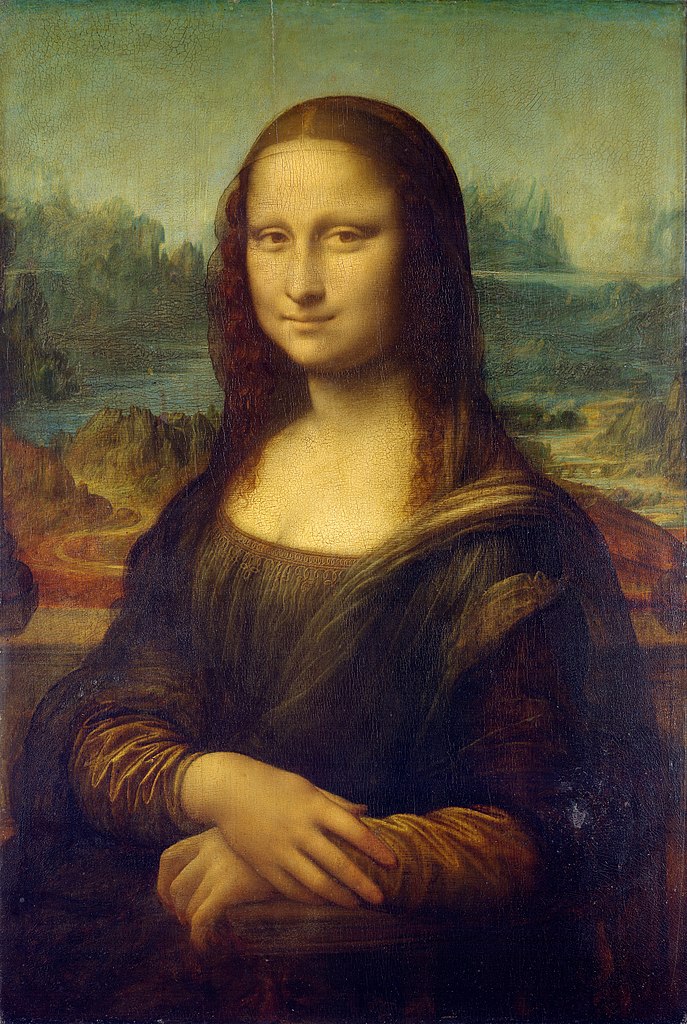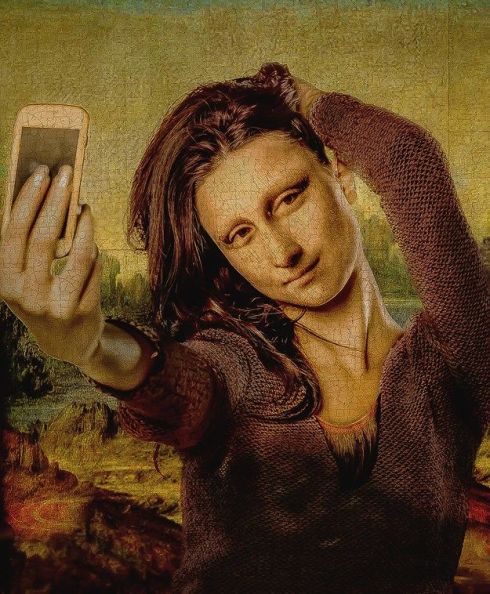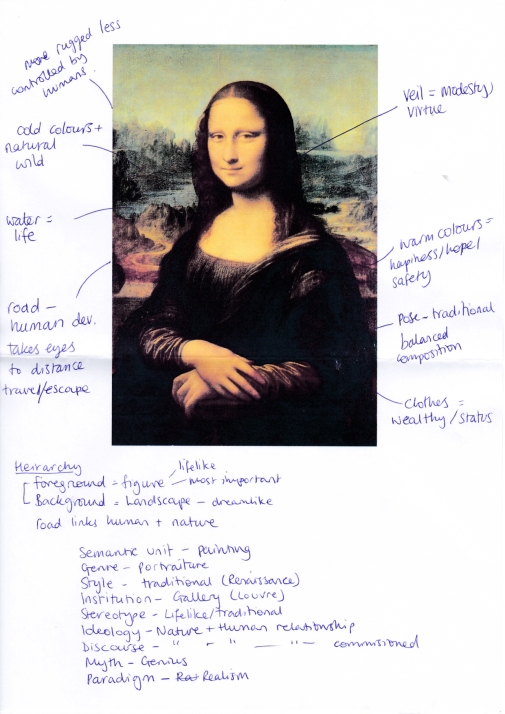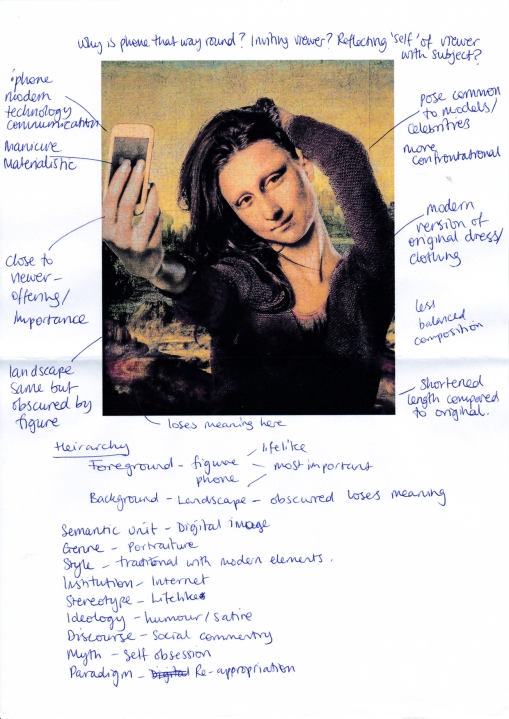In this essay, I will compare Leonardo da Vinci’s Mona Lisa with a re-appropriated image. I will discuss the similarities and differences between them: their purpose, content, context and the relationship that they have with the viewer. I will consider how the re-appropriated image comments on wider social changes that have happened since the original painting was created and how our relationship with the way we view art is changing.

The Mona Lisa is a portrait of Lisa Gherardini, the wife of Francesco del Giocondo, a wealthy merchant. The oil painting is currently displayed at The Louvre, Paris and is thought to have been created between 1503-1517 to celebrate the birth of their second son. Leonardo da Vinci was a polymath – as interested in science and nature as art. In this work, he explores our connection with the natural world.
The painting is probably best known for the enigmatic smile on the sitter’s face. This represents an idea of happiness which is a theme that runs through the whole of the work. Its alternative name, ‘La Gioconda,’ means delightful or happy in Italian and is a pun on the sitter’s married surname (Giocondo) a fact that wouldn’t have gone unnoticed by da Vinci. The artist uses warm colours in both the figure and the background and creates a landscape that seems imaginary. This gives the painting a dreamlike quality, adding to the idea of peace, calm and happiness.
The Mona Lisa was originally situated in Fontainebleau Palace, before being moved to the Palace of Versailles by King Louis XIV. It was briefly kept at Tuileries Palace before finally finding its permanent site at The Louvre. I have only ever seen it as a reproduction in photographs, books and online but seeing the original is definitely on my ‘to do’ list. I think this describes a lot of people’s relationship to art in the modern world. In some ways this is a blessing, we can now access many great works of art at any time and from anywhere, but I also feel that visiting galleries and exhibitions creates a more personal connection between the viewer and the work which can’t be replicated online.
The Mona Lisa is one of the most parodied images in the world. The version I’ve chosen is a digital image available on many social media sites, most commonly on Pinterest. It shows the Mona Lisa as a modern day woman taking a selfie. This comments on the modern way we create portraits and our idea of ‘self.’

I decided to use what I’d learnt about semiotics to make notes of the similarities, differences and meanings between the two images. The second has, I think, a stronger narrative or at least one that is easier to understand (for a modern audience). It is a parody of the original painting in which a young woman uses technology to create an image of herself. In this way, she has control over how she is viewed by the wider world. This is in contrast to the way the original sitter would have felt. Oddly, the phone in this ‘new’ Mona Lisa is the wrong way round and I can’t decide whether this is deliberate or not. The outstretched hand feels like it’s inviting the viewer to interact with the subject; is this a device to suggest that we, the audience, are the ones who will take the photo? Do we then become the subject of our own Mona Lisa?
Regardless of this odd feature, there are other differences between the two portraits. The second has less background, instead, the figure takes up most of the space — this could suggest a feeling of self-importance and disassociation from the landscape behind. She wears modern clothing and the Mona Lisa’s demure qualities have also disappeared — instead, this woman feels confident and her gaze defiant and unapologetic. This is what I find most interesting about the re-appropriated image; the face has not changed, it has been copied from the original painting and so is identical. What has altered, is the context in which we view this woman and the pose chosen by the artist. This shows how such a change can alter meaning.
There are also some similarities between the old and new portraits. They both show a young woman in fashionable clothing of the day. The colour palette used in the second is very similar to the warm colours of the original painting and some of the background is the same. In both, the subject is looking out toward the viewer and both women seem aware of their own identity.
I’m not sure that the theme of happiness is carried through to the newer portrait. The connection between the human form and the landscape around it is lost and the focus of the image shifts to the idea previously discussed of ‘self.’ However, this is a theme common to both works; the original Mona Lisa, being the wife of an influential person, would have been concerned with how she was seen in society just as the Mona Lisa of the re-appropriated version is concerned about her image in today’s social media-obsessed society. I tried to use the learning from Sean Hall’s This means this, this means that to further refine the meaning behind each portrait.


Where the two images are displayed is also a factor in how we feel about them. The Louvre commands our respect as one of the most famous galleries in the world. It has a spiritual quality and as such the art held within takes on this feeling. Millar and Dean discuss “the enduring identity of place” (Dean T. & Millar J. 2005, p.17) this identity goes beyond the physical site, it is the feeling and connection between us and our surroundngs. The re-appropriated work is viewed online, a non-place where work is displayed regardless of quality, often anonymously. This seems to lessen the importance of the newer image. I thought of Sean Hall’s discussion on the way we attach importance to a work depending on its author. The notion that Da Vinci is a genius, therefore, his work is of value links back to the question, what is art? – Does it only have value if it’s viewed in a specific place? What if it doesn’t physically exist? Does it matter if we don’t know who created it?
All of the research in this part has mentioned that meaning can change over time and depends on the background/ culture of the viewer. I think this is true of both portraits. Someone from the 1500s wouldn’t understand the message of the later work nor would perhaps someone from a developing country. In the same way, there would be a proportion of people in the modern world that would see the Mona Lisa as an old portrait and nothing else.
The fact that the newer image can only be viewed online is appropriate to the way we access art today, in the same way as the original oil painting was appropriate to the way art was accessed at the time it was created. The commentary on our increasing obsession with self is one we are all familiar with and one that impacts on the way we feel about the world around us. Perhaps, having so much control over so many aspects of our day to day life has been a derogatory thing. We expect so much, and often end up disappointed when we can’t manipulate events to work out the way we want them to. In this way, we have lost our connection to nature and the world around us that Leonardo da Vinci was so keen to capture in his Mona Lisa.
1278 words
References
Bridgeman Education (n.d.) Mona Lisa [online] Available from: https://www.bridgemaneducation.com/en/asset/3179/summary?context=%7B%22route%22%3A%22assets_search%22%2C%22routeParameters%22%3A%7B%22_format%22%3A%22html%22%2C%22_locale%22%3A%22en%22%2C%22filter_text%22%3A%22mona+lisa%22%7D%7D [accessed 01.05.19]
Dean T., & Millar J. 2005, Place, Thames & Hudson, London
Encyclopedia Britannica (2019) Mona Lisa [online] Available from: https://www.britannica.com/topic/Mona-Lisa-painting [accessed 01.05.19]
Hall S., 2007, This means this, this means that: A users guide to semiotics, Laurence King Publishing, London
Louvre (2019) Mona Lisa – Portrait of Lisa Gherardini, wife of Francesco del Giocondo [online] Available from: https://www.louvre.fr/en/oeuvre-notices/mona-lisa-portrait-lisa-gherardini-wife-francesco-del-giocondo [accessed 01.05.19]
Pinterest (artist unknown) (n.d.) Mona Lisa Selfie [online] Available from: https://www.pinterest.co.uk/pin/233553930662878541/ [accessed 01.05.19]

Leave a comment